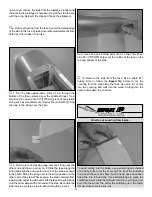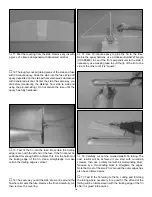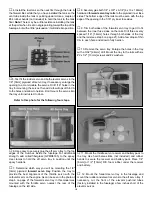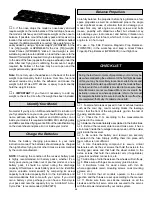
❏
2. Cut out the front and rear instrument panel stickers
and place them in the model (the front instrument panel will
have to be trimmed to accommodate the wing strut blocks).
❏
3. Use the windshield pattern in the back of the manual
to cut out the windshields from the supplied clear plastic
sheets. Start with curved-tip plastic cutting scissors, then
true the edges with progressively finer grits of sandpaper.
❏
4. Have an assistant hold one of the windscreens in
position on the fuse. Use a fine-point felt-tip pen to draw a
line on the fuse around the edge of the windscreen.
Use this photo for the next three steps.
❏
5. Use a hobby knife with a new #11 blade to cut through
the covering along the line you marked. If adding a flat black
anti-glare panel, remove the aluminum covering behind the
line. Use the covering as a template to cut another piece
from flat black MonoKote film (or use fine sandpaper to scuff
a piece of regular black MonoKote film). Iron the “anti-glare”
panel covering into position, with a 1/16" [2mm] gap
between the black and the aluminum. If not making an anti-
glare panel, make another cut in the covering 1/16" [2mm] in
front of the first cut. Remove the strip of covering from the
fuse, leaving a 1/16" [2mm] strip of exposed balsa where the
windscreen will be glued.
❏
6. Use a #11 blade to split both pieces of black rubber
tubing for the cockpit coaming. Fit the coaming around the
cockpit openings with the ends joining at the rear, but don't
glue them into position yet.
❏
7. Prepare the other cockpit the same way.
❏
8. Trim the molded plastic turtledeck to fit the fuse, then
temporarily fit it into position. Trim the rear cockpit coaming
to accommodate the turtledeck.
❏
9. The same way a line was drawn around the
windshields, draw a line around the turtledeck onto the
covering. Remove the turtledeck, then cut the covering 1/16"
[2mm] inside the line you marked and peel off the covering.
❏
10. Wipe away the ink with a tissue dampened with
denatured alcohol. Position the turtledeck, then carefully
glue it into position with thin CA. Avoid using CA activator,
but if necessary, activator may be applied in small amounts
by spraying the CA on a T-pin, then using the T-pin to
transfer small drops where necessary. If rapidly curing CA
fogs the covering or forms small white bubbles, it may be
cleaned up with CA debonder. Use care, because debonder
will also remove the paint from the turtledeck.
❏
11. Use thin CA sparingly to glue the coaming to the fuse.
❏
12. Glue the windscreens to the fuse. This was done on
our prototype models using thin and medium CA as
necessary, but great care must be used not to smear the
windshields by using too much CA. The same as the
turtledeck, CA activator may be applied sparingly with a T-pin.
❏
13. Use CA debonder where necessary to remove CA
that has “fogged” the covering or windshields. This is best
done with a few drops applied to a cotton swab. Note: For
added scale effect, a flat black anti-glare panel was applied
to the front of the fuselage after the front windshield was
glued into position.
❏
14. Assemble your pilots, then paint them with suitable
paint. Acrylic paint (found at craft stores) is recommended.
Securely glue the pilots into the cockpits.
26







































